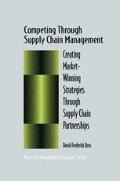Abstract
At the heart of supply chain management (SCM) can be found the continuous unfolding of dynamic organizational, marketplace, and product strategies that enable today’ s enterprise to leverage both the core competencies within its own boundaries as well as the almost limitless capabilities of supply channel partners in the search for new sources of competitive advantage. Unlike conventional strategic planning, which focuses around determining budgets and detailed metrics concerning the expected performance of existing products and processes, companies focused around the SCM paradigm perceive the formulation of business strategies as an opportunity to explore radically new and innovative approaches to the marketplace. Whereas SCM business strategies are concerned with the creation of new visions of logistics that transcend conventional techniques of purchasing, producing, moving, storing, and selling products and services, their real importance resides in their ability to assist executives in designing a clear blueprint for the development of new organizational architectures that will prepare their companies to build uncontested marketplace advantage in the future. SCM strategies can accomplish this objective by deploying new management models, productive processes, and technologies to achieve consistent and continuous breakthroughs in the creation of the products and services customers really want, the acquisition of new productive competencies or the migration of existing competencies to new functional areas, and the targeted utilization of the capabilities of supply channel partners to engineer an interenterprise vertical channel of many diverse competencies drawn together as a seamless, coherent customer-satisfying resource.
Access this chapter
Tax calculation will be finalised at checkout
Purchases are for personal use only
Preview
Unable to display preview. Download preview PDF.
Notes
Steven L. Goldman, Roger N. Nagel, and Kenneth Preiss, Agile Competitors and Virtual Organizations. New York: Van Nostrand Reinhold, 1995, pp. 57–59.
Gary Hamel and C.K. Prahalad, Competing for the Future. Boston, MA: Harvard Business School Press, 1994, pp. 9–10.
Laurie Joan Aron, “Logistics on the Rebound,” Inbound Logistics 15 (2) (February 1995), 34–36.
Terry Hill, Manufacturing Strategy: Text and Cases, 2nd ed. Burr Ridge, IL: Irwin, 1994, pp. 18–20.
James F. Moore, The Death of Competition. New York: HarperBusiness, 1996, pp. 62–63.
Hamel and Prahalad, p. 300.
Michael Hammer and James Champy, Reengineering the Corporation. New York: HarperBusiness, 1993, pp. 86–87.
Hamel and Prahalad, p. 21.
Sun Tzu, The Art of War. Boston: Shambhala, 1988.
Peter F. Drucker, Management: Tasks, Responsibilities, and Practice. New York: Harper and Row, 1973, Chapt. 7.
Robert H. Hayes and Steven C. Wheelwright, Restoring Our Competitive Edge. New York: John Wiley and Sons, 1984, p. 25.
Philip Kotler, Marketing Management, 6th ed. Englewood Cliffs, NJ: Prentice-Hall, 1988, p. 37.
J. Robert Hall, “Top Dog’s View of Supply Channel Management,” Inbound Logistics 16 (6) (June 1996), 23–30.
Hamel and Prahalad, pp. 117–138.
Michael Hammer, Beyond Reeingineering. New York: HarperBusiness, 1996, p. 195.
This results of this report can be found in James Aaron Cooke, “On the Up and UP (and Up)!,” Traffic Management (January 1996), 49–51.
Leslie Hansen Harps, “Case Corp. Constructs Logistics Model of the Future,” Inbound Logistics 16 (10) (October 1996), 25–32.
Robert A. Novack, C. John Langley, and Lloyd M. Rinehart, Creating Logistics Value. Oak Brook, IL: Council of Logistics Management, 1995, p. 221.
James A. Cooke, “PandG’s Mega Gamble,” Traffic Management 34 (12) (December 1995), 33–36.
Kevin O’Laughlin and William Copacino, “Logistics Strategy,” in The Logistics Handbook. ( James F. Robinson and William C. Copacino, eds.). New York: The Free Press, 1994, pp. 57–75.
Author information
Authors and Affiliations
Rights and permissions
Copyright information
© 1998 Springer Science+Business Media New York
About this chapter
Cite this chapter
Ross, D.F. (1998). Developing SCM Strategies. In: Competing Through Supply Chain Management. Springer, Boston, MA. https://doi.org/10.1007/978-1-4757-4816-1_4
Download citation
DOI: https://doi.org/10.1007/978-1-4757-4816-1_4
Publisher Name: Springer, Boston, MA
Print ISBN: 978-1-4419-4727-7
Online ISBN: 978-1-4757-4816-1
eBook Packages: Springer Book Archive

